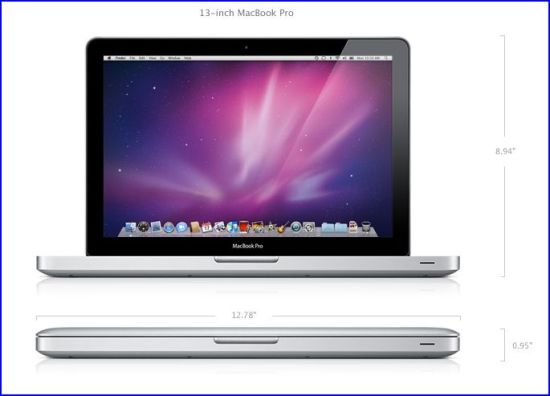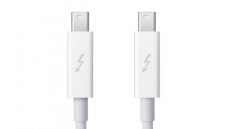
By Gadjo Cardenas Sevilla
The Apple Macbook Pro line has recently been completely revamped from the popular and highly-totable 13-inch MacBook Pro to the larger but more powerful 15 and 17-inch MacBook Pro models.
We tested the new 13-inch MacBook Pro ($1249) which now sports a new Intel Core i5 dual core 2.3GHz processor with turbo boost technology and a whole new high-speed optical I/O format called Thunderbolt. A higher end model with a dual 2.7GHz Intel i7 processor is the most powerful 13-inch MacBook Pro ever made.
Out of the box, the MacBook Pro 13-inch looks and feels identical to the previous model. It is still a profoundly solid and well-balanced notebook built around the innovative unibody aluminum enclosure with a sealed 10-hour battery coupled with a bright yet frugal LED LCD screen and Apple’s black-keyed backlit chiclet keyboard, which is acknowledged by many as the best in the business. That's why it has been unabashedly copied by rival manufacturers except for the backlit part.
This is a third generation of the unibody enclosure and while it looks just like earlier models, many of the earlier problems, glitches and weirdnesses have been weeded out.
There have been some cases, however, where these new MacBook Pro's have seen some screen freezing and flickering issues and problems when connected to external displays and when working on graphic intensive apps which is a black eye for a machine geared for designers, photographers and videographers. These issues have supposedly been "cured" by a recent OS X 10.6.7 software update. We did not experience any of the display issues during our three week test period.

Upon closer inspection, one can spot the spanking new (as in, there’s isn’t anything available in the market to plug into it) Thunderbolt optical port (above photo). Thunderbolt is Intel and Apple’s Light Peak technology which is capable of blazing data transfer speeds as well as the ability to feed and edit HD video in real time. Thunderbolt is 12 times faster than FireWire 800 and 20 times faster than the current standard USB 2.0.

It is interesting to note that Apple has completely ignored the upcoming USB 3.0 standard and successor to USB, a standard Apple helped promote when it released the first generation iMac.
Thunderbolt is where it will focus on and it is clearly the chosen successor to FireWire. We just hope it has Target Disk Mode, a sorely missed feature that died with FireWire.
For most users, this may not mean much but people needing fast transfer rates (for quicker backups) as well as the abiity to feed audio and video out one port will enjoy these ridiculously fast transfer rates. This could revolutionize digital music and film creation and editing and we're excited to see what third party thunderbolt devices have to offer.The devices and peripherals supporting Thunderbolt, however are expected to be expensive.
We were unable to test the Thunderbolt port as we had nothing to connect it to but we're hoping that the port will be used accross Apple's line of products hopefully making its way to the iPad and MacBook Air.
The new MacBook Pros also feature a FaceTime camera, an update to the iChat camera of old and with three times the quality of their predecessor. This makes the MacBook Pro an ideal video chat device out of the box specially now that iPads, iPod Touches, iPhone 4s all have the FaceTime capability.
Performance and Expansion
On the inside, the new MacBook Pros have Intel’s new Core i5 Sandy bridge processor architecture which offers speed and performance increases is said to be twice as powerful than its predecessor. This isn't evident for most tasks like surfing the web, writing email or even playing back movies or music but comes into play once processor intesive tasks are on the line.
Side by side comparison with our workhorse 13-inch MacBook Pro from a year ago (2.4GHz with 6GB of RAM) our review loaner showed an impressive increase in performance specially when dealing with graphics and video.
To really put the MacBook Pro’s muscle to the test we went with the most processor intensive app that ships with the Macs, iMovie. We processed a 10 minute video with some effects and transitionsand the older MacBook Pro did it in around 12 minutes, while the newer one crunched it in roughly 5 minutes.
What was surprising was our older MacBook Pro had more RAM (6GB) than the bone-stock demo (4GB) but everything in iMovie just felt a lot faster.
Another thing about the new MacBook Pro is that it is pretty expandable. You can, for example, add up to 16GB of 1333MHz RAM and a up to 1Terabyte hard drive if you need to. Other World Computer (macsales.com) offers these pricey but nonetheless amazing D.I.Y. upgrades.
The new MacBook Pro is probably one of the most powerful notebooks in its class. While cheap it ain’t at a starting price of $1250, you do get a pretty future proof (at least for the next five years) portable Mac that has more than enough processing power to rival some desktop computers and the ability to run both OS X and Windows, even simultaneously without breaking a sweat.
We're just hoping those freezes and graphics issues are a thing of the past.
Rating: 4.0 out of 5